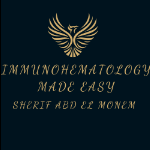
Eman
MembersEman last won the day on July 29 2017
Eman had the most liked content!
About Eman
- Birthday 06/06/1975
Profile Information
-
Gender
Male
-
Location
Minnesota USA
-
Occupation
Quality Assurance - BMT program, sometimes software and blood products
Recent Profile Visitors
2,089 profile views
Eman's Achievements
-
 Eman reacted to a post in a topic:
honoring BMT special needs
Eman reacted to a post in a topic:
honoring BMT special needs
-
Current employer has been using Chloraprep for years, with a small number of the povidone-iodine combo scrubs available for the rare donor with an allergy to chloraprep (I think that's super rare but have no data, but I know we've had event reports about expired PI swabs being available). My prior employer, 2004-2011, also used Chloraprep exclusively (although probably not in 2004, I don't recall exactly when Chloraprep became available). I have always had a good impression of the chloraprep scrubs.
-
Ah, you are correct, its a bit vague, but we treated it like a strong recommendation and only made RBCs from whole blood that took longer than 20' to collect.
-
There's a comment in the Technical Manual about not making cryo from units that take more than 15-20 minutes to collect, the organizations I've been have used that guideline to determine manufacturing. As well as the no clots part of course
-
 AB123 reacted to a post in a topic:
AABB Transition To New Standards
AB123 reacted to a post in a topic:
AABB Transition To New Standards
-
 David Saikin reacted to a post in a topic:
AABB Transition To New Standards
David Saikin reacted to a post in a topic:
AABB Transition To New Standards
-
I think we would refer to this statement in our "Organization" Quality Program document: The Quality Unit responsibilities are defined and include: active and prospective participation in quality planning; oversight of all activities relating to quality; ensuring that policies and procedures are properly maintained and executed; ensuring that the quality of products, tests, and services provided conform to regulatory/accreditation, customer, and company standards; and maintenance of the facility quality manual
-
 Eman reacted to a post in a topic:
Blood Shortage
Eman reacted to a post in a topic:
Blood Shortage
-
 Eman reacted to a post in a topic:
Blood Shortage
Eman reacted to a post in a topic:
Blood Shortage
-
 Eman reacted to a post in a topic:
Inappropriate Override by a Manager
Eman reacted to a post in a topic:
Inappropriate Override by a Manager
-
 Eman reacted to a post in a topic:
Inappropriate Override by a Manager
Eman reacted to a post in a topic:
Inappropriate Override by a Manager
-
 Eman reacted to a post in a topic:
BACTERIAL TESTING FOR SD PLATELETS
Eman reacted to a post in a topic:
BACTERIAL TESTING FOR SD PLATELETS
-
 Eman reacted to a post in a topic:
CORD BLOOD NOT MATCHING HEEL STICK TYPE
Eman reacted to a post in a topic:
CORD BLOOD NOT MATCHING HEEL STICK TYPE
-
 Eman reacted to a post in a topic:
CMV "Safe" blood
Eman reacted to a post in a topic:
CMV "Safe" blood
-
Hi, I can only answer some of your questions: We have had a Trauma WB protocol in place for a while. Below are our use restrictions, we generally only have 2-6 of these products available, so most recipients do get switched to RBCs after the initial WB transfusion(s). These are not crossmatched, being for trauma situations only, and are in fact issued on back up and reconciled in the LIS afterwards. Since we limit it to two products until the patient is typed, and they wouldn't get a group O after an incompatibility is identified, I don't believe we've had any typing issues subsequent to the WB transfusion. Seems like mixed field could be a confounder though. • Product Use: o Limited to adult patients weighing 40 kg or more o Untyped recipients will not receive more than two of these units. o Women of child bearing age and individuals with unknown Rh type will receive Rh negative products. o Adult males and women not of childbearing potential (55 years of age and older) will receive Rh positive products. A lot of these products went unused at first, but use picked up in the 2nd year of the program (I think we're in year 3 now)
-
 Eman reacted to a post in a topic:
Group O platelets titer
Eman reacted to a post in a topic:
Group O platelets titer
-
 Eman reacted to a post in a topic:
FFP and RBC's Administered through same line simultaneously
Eman reacted to a post in a topic:
FFP and RBC's Administered through same line simultaneously
-
FWIW, we give our Trauma WB products a two week expiration date, because of the declining platelet function.
-
 BloodBanker80 reacted to a post in a topic:
Volume (Plasma) Reduced Platelet
BloodBanker80 reacted to a post in a topic:
Volume (Plasma) Reduced Platelet
-
When we were bringing up a platelet collection system I asked the manufacturer some questions about the bag volume limits (100-400mL) and time spent where the volume was greater than 400mL. This scenario occurs for example when a 500mL intended-double is collected, but stored in one bag until counting/processing begins after the collection. That manufacturer said you could go up to 24 hours "out of range" before you compromised the product. Similar concerns about the storage concentration, the manufacturer has validated an acceptable platelet concentration range, odds are your volume reduction process results in a concentration greater than their validated upper limit. With your closed system scenario I'd be uncomfortable giving the volume reduced product more than 24 hours without having validation data showing viability past that point. Due to container, volume and [PLT] concerns. At a previous employer we volume reduced platelets and they were pretty ugly products, my current employer no longer volume reduces platelets, we give multiple divided aliquots instead. [sorry for reiterating some of the points made earlier. they're good points ]
-
We were using TempTales for quite a while, but "suddenly" had trouble getting some cooler validations to pass. That's when we realized that the TempTales had a fairly large +/- tolerance, too large when validating a 1-6°C range. So our transfusion service ordered up some LogTags, they've been very happy with those over the past couple years.
-
Your questions need a bit more context I think, not really sure if you're talking transfusion service or blood center. But maybe this will help. 1) In a US blood center setting, when processing freshly collected whole blood into RBCs and a plasma product, a second spin is typically allowed if there is blood in the ports (which means that blood would go through the port into the plasma bag) or poor RBC/Plasma separation. Typically you'd clear the ports, gently remix the WB a bit and then respin. Additional WB spins are not allowed. The centrifuge settings should be validated for your WB processing and you shouldn't see reddish plasma too often. 2) We leukoreduce before the WB is separated into RBCs and Plasma, and bedside filters are standard. So not sure what you mean about the filter step. Washing and irradiating could be done in either order, but sometimes your computer system may define your process (for a while at my current employer you had to irradiate before washing because our computer system wasn't set up to allow you to wash and then irradiate, that modification path wasn't defined in the computer system). Washing shortens your outdate drastically while irradiation only reduces it to 4 weeks or the existing expiration date if shorter, so irradiating first might make more sense. 3) If you don't use a sterile connection device during your cryo production you've got an open system, and remember that freezing doesn't actually destroy any introduced bacteria. If you are making pooled cryo, using an open system shortens your thawed shelf life from six hours to four hours, but if you sterile dock during that process you get six hours. I'm not actually sure about single cryo units, you probably still have the four shelf life on that product after thawing. (and if you make open system single units and then pool you'll only get the four hour shelf life even if you do sterile dock during pooling). Closed system for making singles and pooling is pretty much the standard practice.
-
Fair question, I'm sure it depends on if the manufacturer makes the claim or not. Cerus is the only licensed PRT provider/system in the US and their package insert states it will "potentially reduce the risk of TA-GVHD." Not as strong a statement as I expected, but our medical leadership has taken it to heart. Perhaps we will see a case report in a few years, hopefully not!
-
The folks handling BPDRs are different people than the inspectors, I don't think anyone does both. My/our groups interactions with BPDR submissions have been very positive, sometimes we're told it's not actually reportable, sometimes they tell us they changed the classification code. I've also had positive interactions writing in to ask if a situation is reportable (I switched from QA support of BBTS to HCTP a year or so ago, so have had a LOT of questions. Rather different on the HCTP side).
-
Curious what you mean, the pathogen reduction (PRT) is FDA cleared and accepted to replace irradiation due to GVHD concerns. Prior to implementing that our platelets were 100% irradiated, just to be safe. There is a rWBC threshold for the PRT process, we still do QC on rWBC on the platelets to make sure we're lower than the limit. And RBCs get irradiated when patient needs indicate. But totally agree that LR filters do not remove 100% of WBCs, and since it's not 100% tested some over the limit may slip through. More of concern with RBCs though, which are irradiated as needed. The apheresis tech is pretty reliable when it comes to LR.
-
 MOBB reacted to a post in a topic:
Thank You!
MOBB reacted to a post in a topic:
Thank You!
-
 R1R2 reacted to a post in a topic:
FDA reportable events
R1R2 reacted to a post in a topic:
FDA reportable events
-
There's an annual BPDR summary for BB/TS from the FDA, looks like 2016 is the most recent available at: https://www.fda.gov/BiologicsBloodVaccines/SafetyAvailability/ReportaProblem/BiologicalProductDeviations/ucm129757.htm 1,956 BPDRs from Transfusion Services in 2016, a majority being QC and distribution related, not documenting issue in the computer system is typically the #1 reason.
-
I guess I could clarify that our validation environment (and training environment) is identical to the live production environment, except the "other" two environments don't interface to billing.
-
I know we have users from multiple countries here, another confounding point is that the US considers leukoreduction to have less than 5*10^6 WBCs left, but the EU standard is less than 1*10^ WBCs in the product. One nice thing about having implemented pathogen reduction for platelets is we can stop irradiating for GVHD, since the pathogen reduction also stops WBCs from being able to reproduce (the platelet products are still coming off the machine leukoreduced too).


